
- •CONTENTS
- •1.1 Introduction
- •1.2 What Is a Computer?
- •1.3 Programs
- •1.4 Operating Systems
- •1.5 Java, World Wide Web, and Beyond
- •1.6 The Java Language Specification, API, JDK, and IDE
- •1.7 A Simple Java Program
- •1.8 Creating, Compiling, and Executing a Java Program
- •1.9 (GUI) Displaying Text in a Message Dialog Box
- •2.1 Introduction
- •2.2 Writing Simple Programs
- •2.3 Reading Input from the Console
- •2.4 Identifiers
- •2.5 Variables
- •2.7 Named Constants
- •2.8 Numeric Data Types and Operations
- •2.9 Problem: Displaying the Current Time
- •2.10 Shorthand Operators
- •2.11 Numeric Type Conversions
- •2.12 Problem: Computing Loan Payments
- •2.13 Character Data Type and Operations
- •2.14 Problem: Counting Monetary Units
- •2.15 The String Type
- •2.16 Programming Style and Documentation
- •2.17 Programming Errors
- •2.18 (GUI) Getting Input from Input Dialogs
- •3.1 Introduction
- •3.2 boolean Data Type
- •3.3 Problem: A Simple Math Learning Tool
- •3.4 if Statements
- •3.5 Problem: Guessing Birthdays
- •3.6 Two-Way if Statements
- •3.7 Nested if Statements
- •3.8 Common Errors in Selection Statements
- •3.9 Problem: An Improved Math Learning Tool
- •3.10 Problem: Computing Body Mass Index
- •3.11 Problem: Computing Taxes
- •3.12 Logical Operators
- •3.13 Problem: Determining Leap Year
- •3.14 Problem: Lottery
- •3.15 switch Statements
- •3.16 Conditional Expressions
- •3.17 Formatting Console Output
- •3.18 Operator Precedence and Associativity
- •3.19 (GUI) Confirmation Dialogs
- •4.1 Introduction
- •4.2 The while Loop
- •4.3 The do-while Loop
- •4.4 The for Loop
- •4.5 Which Loop to Use?
- •4.6 Nested Loops
- •4.7 Minimizing Numeric Errors
- •4.8 Case Studies
- •4.9 Keywords break and continue
- •4.10 (GUI) Controlling a Loop with a Confirmation Dialog
- •5.1 Introduction
- •5.2 Defining a Method
- •5.3 Calling a Method
- •5.4 void Method Example
- •5.5 Passing Parameters by Values
- •5.6 Modularizing Code
- •5.7 Problem: Converting Decimals to Hexadecimals
- •5.8 Overloading Methods
- •5.9 The Scope of Variables
- •5.10 The Math Class
- •5.11 Case Study: Generating Random Characters
- •5.12 Method Abstraction and Stepwise Refinement
- •6.1 Introduction
- •6.2 Array Basics
- •6.3 Problem: Lotto Numbers
- •6.4 Problem: Deck of Cards
- •6.5 Copying Arrays
- •6.6 Passing Arrays to Methods
- •6.7 Returning an Array from a Method
- •6.8 Variable-Length Argument Lists
- •6.9 Searching Arrays
- •6.10 Sorting Arrays
- •6.11 The Arrays Class
- •7.1 Introduction
- •7.2 Two-Dimensional Array Basics
- •7.3 Processing Two-Dimensional Arrays
- •7.4 Passing Two-Dimensional Arrays to Methods
- •7.5 Problem: Grading a Multiple-Choice Test
- •7.6 Problem: Finding a Closest Pair
- •7.7 Problem: Sudoku
- •7.8 Multidimensional Arrays
- •8.1 Introduction
- •8.2 Defining Classes for Objects
- •8.3 Example: Defining Classes and Creating Objects
- •8.4 Constructing Objects Using Constructors
- •8.5 Accessing Objects via Reference Variables
- •8.6 Using Classes from the Java Library
- •8.7 Static Variables, Constants, and Methods
- •8.8 Visibility Modifiers
- •8.9 Data Field Encapsulation
- •8.10 Passing Objects to Methods
- •8.11 Array of Objects
- •9.1 Introduction
- •9.2 The String Class
- •9.3 The Character Class
- •9.4 The StringBuilder/StringBuffer Class
- •9.5 Command-Line Arguments
- •9.6 The File Class
- •9.7 File Input and Output
- •9.8 (GUI) File Dialogs
- •10.1 Introduction
- •10.2 Immutable Objects and Classes
- •10.3 The Scope of Variables
- •10.4 The this Reference
- •10.5 Class Abstraction and Encapsulation
- •10.6 Object-Oriented Thinking
- •10.7 Object Composition
- •10.8 Designing the Course Class
- •10.9 Designing a Class for Stacks
- •10.10 Designing the GuessDate Class
- •10.11 Class Design Guidelines
- •11.1 Introduction
- •11.2 Superclasses and Subclasses
- •11.3 Using the super Keyword
- •11.4 Overriding Methods
- •11.5 Overriding vs. Overloading
- •11.6 The Object Class and Its toString() Method
- •11.7 Polymorphism
- •11.8 Dynamic Binding
- •11.9 Casting Objects and the instanceof Operator
- •11.11 The ArrayList Class
- •11.12 A Custom Stack Class
- •11.13 The protected Data and Methods
- •11.14 Preventing Extending and Overriding
- •12.1 Introduction
- •12.2 Swing vs. AWT
- •12.3 The Java GUI API
- •12.4 Frames
- •12.5 Layout Managers
- •12.6 Using Panels as Subcontainers
- •12.7 The Color Class
- •12.8 The Font Class
- •12.9 Common Features of Swing GUI Components
- •12.10 Image Icons
- •13.1 Introduction
- •13.2 Exception-Handling Overview
- •13.3 Exception-Handling Advantages
- •13.4 Exception Types
- •13.5 More on Exception Handling
- •13.6 The finally Clause
- •13.7 When to Use Exceptions
- •13.8 Rethrowing Exceptions
- •13.9 Chained Exceptions
- •13.10 Creating Custom Exception Classes
- •14.1 Introduction
- •14.2 Abstract Classes
- •14.3 Example: Calendar and GregorianCalendar
- •14.4 Interfaces
- •14.5 Example: The Comparable Interface
- •14.6 Example: The ActionListener Interface
- •14.7 Example: The Cloneable Interface
- •14.8 Interfaces vs. Abstract Classes
- •14.9 Processing Primitive Data Type Values as Objects
- •14.10 Sorting an Array of Objects
- •14.11 Automatic Conversion between Primitive Types and Wrapper Class Types
- •14.12 The BigInteger and BigDecimal Classes
- •14.13 Case Study: The Rational Class
- •15.1 Introduction
- •15.2 Graphical Coordinate Systems
- •15.3 The Graphics Class
- •15.4 Drawing Strings, Lines, Rectangles, and Ovals
- •15.5 Case Study: The FigurePanel Class
- •15.6 Drawing Arcs
- •15.7 Drawing Polygons and Polylines
- •15.8 Centering a String Using the FontMetrics Class
- •15.9 Case Study: The MessagePanel Class
- •15.10 Case Study: The StillClock Class
- •15.11 Displaying Images
- •15.12 Case Study: The ImageViewer Class
- •16.1 Introduction
- •16.2 Event and Event Source
- •16.3 Listeners, Registrations, and Handling Events
- •16.4 Inner Classes
- •16.5 Anonymous Class Listeners
- •16.6 Alternative Ways of Defining Listener Classes
- •16.7 Problem: Loan Calculator
- •16.8 Window Events
- •16.9 Listener Interface Adapters
- •16.10 Mouse Events
- •16.11 Key Events
- •16.12 Animation Using the Timer Class
- •17.1 Introduction
- •17.2 Buttons
- •17.3 Check Boxes
- •17.4 Radio Buttons
- •17.5 Labels
- •17.6 Text Fields
- •17.7 Text Areas
- •17.8 Combo Boxes
- •17.9 Lists
- •17.10 Scroll Bars
- •17.11 Sliders
- •17.12 Creating Multiple Windows
- •18.1 Introduction
- •18.2 Developing Applets
- •18.3 The HTML File and the <applet> Tag
- •18.4 Applet Security Restrictions
- •18.5 Enabling Applets to Run as Applications
- •18.6 Applet Life-Cycle Methods
- •18.7 Passing Strings to Applets
- •18.8 Case Study: Bouncing Ball
- •18.9 Case Study: TicTacToe
- •18.10 Locating Resources Using the URL Class
- •18.11 Playing Audio in Any Java Program
- •18.12 Case Study: Multimedia Animations
- •19.1 Introduction
- •19.2 How is I/O Handled in Java?
- •19.3 Text I/O vs. Binary I/O
- •19.4 Binary I/O Classes
- •19.5 Problem: Copying Files
- •19.6 Object I/O
- •19.7 Random-Access Files
- •20.1 Introduction
- •20.2 Problem: Computing Factorials
- •20.3 Problem: Computing Fibonacci Numbers
- •20.4 Problem Solving Using Recursion
- •20.5 Recursive Helper Methods
- •20.6 Problem: Finding the Directory Size
- •20.7 Problem: Towers of Hanoi
- •20.8 Problem: Fractals
- •20.9 Problem: Eight Queens
- •20.10 Recursion vs. Iteration
- •20.11 Tail Recursion
- •APPENDIXES
- •INDEX

6.11 The Arrays Class 223
6.11 The Arrays Class
The java.util.Arrays class contains various static methods for sorting and searching arrays, comparing arrays, and filling array elements. These methods are overloaded for all primitive types.
You can use the sort method to sort a whole array or a partial array. For example, the fol- sort lowing code sorts an array of numbers and an array of characters.
double[] numbers = {6.0, 4.4, 1.9, 2.9, 3.4, 3.5}; java.util.Arrays.sort(numbers); // Sort the whole array
char[] chars = {'a', 'A', '4', 'F', 'D', 'P'}; java.util.Arrays.sort(chars, 1, 3); // Sort part of the array
Invoking sort(numbers) sorts the whole array numbers. Invoking sort(chars, 1, 3) sorts a partial array from chars[1] to chars[3-1].
You can use the binarySearch method to search for a key in an array. The array must be binarySearch presorted in increasing order. If the key is not in the array, the method returns –(insertion
index + 1). For example, the following code searches the keys in an array of integers and an array of characters.
int[] list = {2, 4, 7, 10, 11, 45, 50, 59, 60, 66, 69, 70, 79}; System.out.println("(1) Index is " +
java.util.Arrays.binarySearch(list, 11)); System.out.println("(2) Index is " +
java.util.Arrays.binarySearch(list, 12));
char[] chars = {'a', 'c', 'g', 'x', 'y', 'z'}; System.out.println("(3) Index is " +
java.util.Arrays.binarySearch(chars, 'a')); System.out.println("(4) Index is " +
java.util.Arrays.binarySearch(chars, 't'));
The output of the preceding code is
(1)Index is 4
(2)Index is -6
(3)Index is 0
(4)Index is -4
You can use the equals method to check whether two arrays are equal. Two arrays are equal equals if they have the same contents. In the following code, list1 and list2 are equal, but list2
and list3 are not.
int[] list1 = {2, 4, 7, 10}; int[] list2 = {2, 4, 7, 10}; int[] list3 = {4, 2, 7, 10};
System.out.println(java.util.Arrays.equals(list1, list2)); // true
System.out.println(java.util.Arrays.equals(list2, list3)); // false
You can use the fill method to fill in all or part of the array. For example, the following code fill fills list1 with 5 and fills 8 into elements list2[1] and list2[3-1].
int[] list1 = {2, 4, 7, 10}; int[] list2 = {2, 4, 7, 10};
java.util.Arrays.fill(list1, 5); // Fill 5 to the whole array java.util.Arrays.fill(list2, 1, 3, 8); // Fill 8 to a partial array

224 Chapter 6 Single-Dimensional Arrays
KEY TERMS
anonymous array |
209 |
index 198 |
|
|
array 198 |
|
|
indexed variable 200 |
|
array initializer |
201 |
insertion sort |
219 |
|
binary search |
216 |
|
linear search |
216 |
garbage collection |
208 |
selection sort |
219 |
|
CHAPTER SUMMARY
1.A variable is declared as an array type using the syntax elementType[] arrayRefVar or elementType arrayRefVar[]. The style elementType[] arrayRefVar is preferred, although elementType arrayRefVar[] is legal.
2.Unlike declarations for primitive data type variables, the declaration of an array variable does not allocate any space in memory for the array. An array variable is not a primitive data type variable. An array variable contains a reference to an array.
3.You cannot assign elements to an array unless it has already been created. You can create an array by using the new operator with the following syntax: new elementType[arraySize].
4.Each element in the array is represented using the syntax arrayRefVar[index]. An index must be an integer or an integer expression.
5.After an array is created, its size becomes permanent and can be obtained using arrayRefVar.length. Since the index of an array always begins with 0, the last index is always arrayRefVar.length - 1. An out-of-bounds error will occur if you attempt to reference elements beyond the bounds of an array.
6.Programmers often mistakenly reference the first element in an array with index 1, but it should be 0. This is called the index off-by-one error.
7.When an array is created, its elements are assigned the default value of 0 for the numeric primitive data types, '\u0000' for char types, and false for boolean types.
8.Java has a shorthand notation, known as the array initializer, which combines in one statement declaring an array, creating an array, and initializing, using the syntax: elementType[] arrayRefVar = {value0, value1, ..., valuek}.
9.When you pass an array argument to a method, you are actually passing the reference of the array; that is, the called method can modify the elements in the caller’s original array.
REVIEW QUESTIONS
Section 6.2
6.1How do you declare and create an array?
6.2How do you access elements of an array?

Review Questions 225
6.3Is memory allocated for an array when it is declared? When is the memory allocated for an array? What is the printout of the following code?
int x = 30;
int[] numbers = new int[x]; x = 60;
System.out.println("x is " + x);
System.out.println("The size of numbers is " + numbers.length);
6.4Indicate true or false for the following statements:
■Every element in an array has the same type.
■The array size is fixed after it is declared.
■The array size is fixed after it is created.
■The elements in an array must be of primitive data type.
6.5Which of the following statements are valid array declarations?
int i = new int(30);
double d[] = new double[30]; char[] r = new char(1..30); int i[] = (3, 4, 3, 2); float f[] = {2.3, 4.5, 6.6}; char[] c = new char();
6.6What is the array index type? What is the lowest index? What is the representation of the third element in an array named a?
6.7Write statements to do the following:
a.Create an array to hold 10 double values.
b.Assign value 5.5 to the last element in the array.
c.Display the sum of the first two elements.
d.Write a loop that computes the sum of all elements in the array.
e.Write a loop that finds the minimum element in the array.
f.Randomly generate an index and display the element of this index in the array.
g.Use an array initializer to create another array with initial values 3.5, 5.5,
4.52, and 5.6.
6.8What happens when your program attempts to access an array element with an invalid index?
6.9Identify and fix the errors in the following code:
1 public class Test {
2 public static void main(String[] args) {
3 double[100] r;
4
5 for (int i = 0; i < r.length(); i++);
6r(i) = Math.random * 100;
7 |
} |
8 |
} |
Section 6.3
6.10Use the arraycopy() method to copy the following array to a target array t:
int[] source = {3, 4, 5};
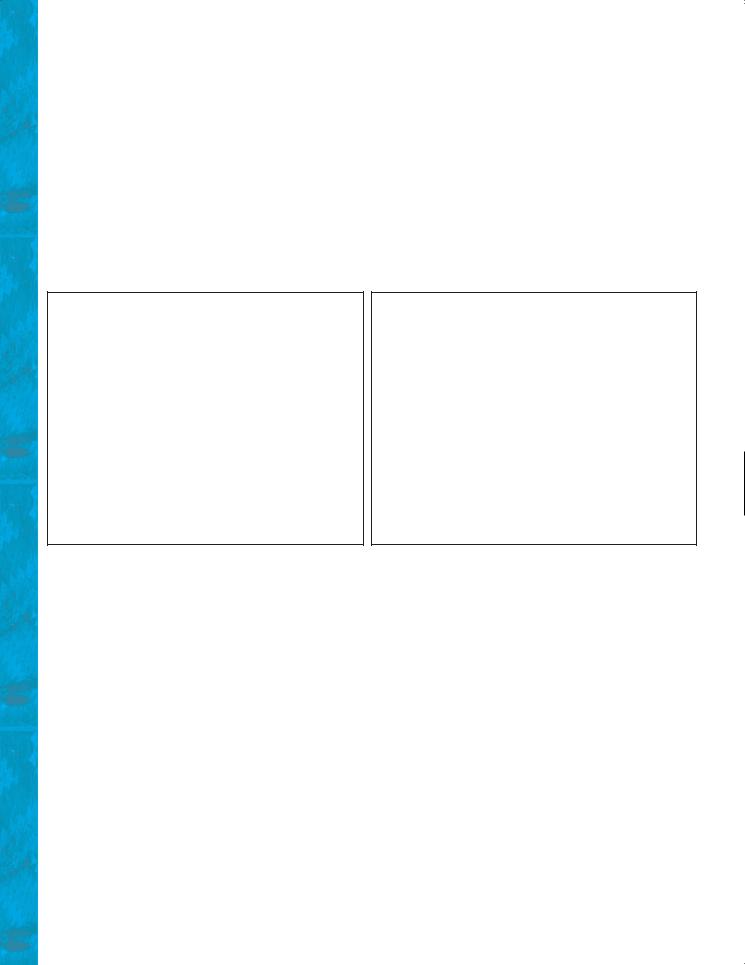
226Chapter 6 Single-Dimensional Arrays
6.11Once an array is created, its size cannot be changed. Does the following code resize the array?
int[] myList;
myList = new int[10];
// Some time later you want to assign a new array to myList myList = new int[20];
Sections 6.4–6.7
6.12When an array is passed to a method, a new array is created and passed to the method. Is this true?
6.13Show the output of the following two programs:
public class Test {
public static void main(String[] args) { int number = 0;
int[] numbers = new int[1]; m(number, numbers);
System.out.println("number is " + number + " and numbers[0] is " + numbers[0]);
}
public static void m(int x, int[] y) { x = 3;
y[0] = 3;
}
}
public class Test {
public static void main(String[] args) { int[] list = {1, 2, 3, 4, 5}; reverse(list);
for (int i = 0; i < list.length; i++) System.out.print(list[i] + " ");
}
public static void reverse(int[] list) { int[] newList = new int[list.length];
for (int i = 0; i < list.length; i++) newList[i] = list[list.length - 1 - i];
list = newList;
}
}
a |
b |
6.14Where are the arrays stored during execution? Show the contents of the stack and heap during and after executing createArray, displayArray, countLetters, displayCounts in Listing 6.4.
Section 6.8
6.15What is wrong in the following method declaration?
public static void print(String... strings, double... numbers) public static void print(double... numbers, String name) public static double... print(double d1, double d2)
6.16Can you invoke the printMax method in Listing 6.5 using the following statements?
printMax(1, 2, 2, 1, 4); printMax(new double[]{1, 2, 3}); printMax(new int[]{1, 2, 3});
Sections 6.9–6.10
6.17Use Figure 6.9 as an example to show how to apply the binary search approach to a search for key 10 and key 12 in list 52, 4, 7, 10, 11, 45, 50, 59, 60, 66, 69, 70,
796.

Programming Exercises 227
6.18Use Figure 6.11 as an example to show how to apply the selection-sort approach to sort 53.4, 5, 3, 3.5, 2.2, 1.9, 26.
6.19Use Figure 6.12 as an example to show how to apply the insertion-sort approach to sort 53.4, 5, 3, 3.5, 2.2, 1.9, 26.
6.20How do you modify the selectionSort method in Listing 6.8 to sort numbers in decreasing order?
6.21How do you modify the insertionSort method in Listing 6.9 to sort numbers in decreasing order?
Section 6.11
6.22What types of array can be sorted using the java.util.Arrays.sort method? Does this sort method create a new array?
6.23To apply java.util.Arrays.binarySearch(array, key), should the array be sorted in increasing order, in decreasing order, or neither?
6.24Show the contents of the array after the execution of each line.
int[] list = {2, 4, 7, 10}; java.util.Arrays.fill(list, 7); java.util.Arrays.fill(list, 1, 3, 8); System.out.print(java.util.Arrays.equals(list, list));
PROGRAMMING EXERCISES
Section 6.2
6.1* (Assigning grades) Write a program that reads student scores, gets the best score, and then assigns grades based on the following scheme:
Grade is A if score is 7 = best - 10;
Grade is B if score is 7 = best - 20;
Grade is C if score is 7 = best - 30;
Grade is D if score is 7 = best - 40;
Grade is F otherwise.
The program prompts the user to enter the total number of students, then prompts the user to enter all of the scores, and concludes by displaying the grades. Here is a sample run:
Enter the number of students: 4
Enter 4 scores: 40 55 70 58 
Student 0 score is 40 and grade is C
Student 1 score is 55 and grade is B
Student 2 score is 70 and grade is A
Student 3 score is 58 and grade is B
6.2(Reversing the numbers entered) Write a program that reads ten integers and displays them in the reverse of the order in which they were read.
6.3** (Counting occurrence of numbers) Write a program that reads the integers between 1 and 100 and counts the occurrences of each. Assume the input ends with 0. Here is a sample run of the program:
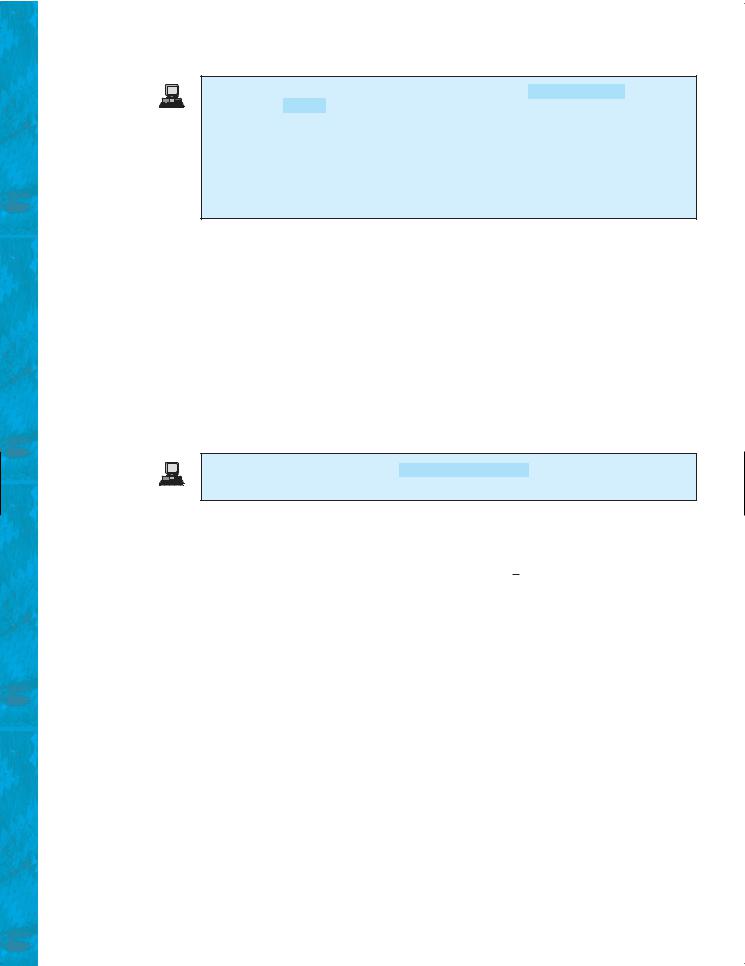
228 Chapter 6 Single-Dimensional Arrays
Enter the integers between 1 and 100: 2 5 6 5 4 3 23 43 2 0 
2 occurs 2 times
3 occurs 1 time
4 occurs 1 time
5 occurs 2 times
6 occurs 1 time
23 occurs 1 time
43 occurs 1 time
Note that if a number occurs more than one time, the plural word “times” is used in the output.
6.4(Analyzing scores) Write a program that reads an unspecified number of scores and determines how many scores are above or equal to the average and how many scores are below the average. Enter a negative number to signify the end of the input. Assume that the maximum number of scores is 10.
6.5** (Printing distinct numbers) Write a program that reads in ten numbers and displays distinct numbers (i.e., if a number appears multiple times, it is displayed only once). Hint: Read a number and store it to an array if it is new. If the number is already in the array, ignore it. After the input, the array contains the distinct numbers. Here is the sample run of the program:
Enter ten numbers: 1 2 3 2 1 6 3 4 5 2 
The distinct numbers are: 1 2 3 6 4 5
6.6* (Revising Listing 4.14, PrimeNumber.java) 1Listing 4.14 determines whether a number n is prime by checking whether 2, 3, 4, 5, 6, Á , n/2 is a divisor. If a divisor is found, n is not prime. A more efficient approach is to check whether any of the prime numbers less than or equal to n can divide n evenly. If not, n is prime. Rewrite Listing 4.11 to display the first 50 prime numbers using this approach. You need to use an array to store the prime numbers and later use them to check whether they are possible divisors for n.
6.7* (Counting single digits) Write a program that generates 100 random integers between 0 and 9 and displays the count for each number. (Hint: Use (int)(Math.random() * 10) to generate a random integer between 0 and 9. Use an array of ten integers, say counts, to store the counts for the number of 0s, 1s, Á , 9s.)
Sections 6.4–6.7
6.8(Averaging an array) Write two overloaded methods that return the average of an array with the following headers:
public static int average(int[] array) public static double average(double[] array)
Write a test program that prompts the user to enter ten double values, invokes this method, and displays the average value.
6.9(Finding the smallest element) Write a method that finds the smallest element in an array of integers using the following header:
public static double min(double[] array)
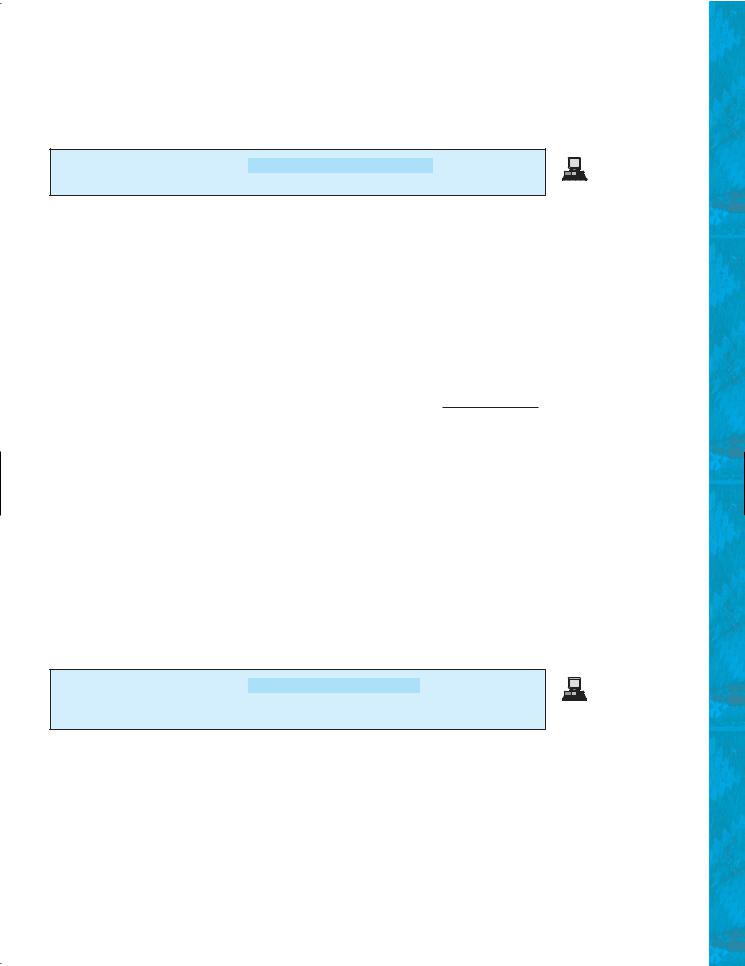
Programming Exercises 229
Write a test program that prompts the user to enter ten numbers, invokes this method to return the minimum value, and displays the minimum value. Here is a sample run of the program:
Enter ten numbers: 1.9 2.5 3.7 2 1.5 6 3 4 5 2 
The minimum number is: 1.5
6.10(Finding the index of the smallest element) Write a method that returns the index of the smallest element in an array of integers. If the number of such elements is greater than 1, return the smallest index. Use the following header:
public static int indexOfSmallestElement(double[] array)
Write a test program that prompts the user to enter ten numbers, invokes this method to return the index of the smallest element, and displays the index.
6.11* (Statistics: computing deviation) Exercise 5.21 computes the standard deviation of numbers. This exercise uses a different but equivalent formula to compute the standard deviation of n numbers.
|
n |
|
|
deviation = Q |
n |
|
1xi - mean22 |
|
axi |
|
x1 + x2 + Á + xn |
a |
|||
mean = |
i= 1 |
= |
i= |
1 |
|
||
n |
n |
|
|
n - 1 |
|||
To compute deviation with this formula, you have to store the individual numbers using an array, so that they can be used after the mean is obtained.
Your program should contain the following methods:
/** Compute the deviation of double values*/ public static double deviation(double[] x)
/** Compute the mean of an array of double values*/ public static double mean(double[] x)
Write a test program that prompts the user to enter ten numbers and displays the mean and deviation, as shown in the following sample run:
Enter ten numbers: 1.9 2.5 3.7 2 1 6 3 4 5 2 
The mean is 3.11
The standard deviation is 1.55738
6.12* (Reversing an array) The reverse method in §6.7 reverses an array by copying it to a new array. Rewrite the method that reverses the array passed in the argument and returns this array. Write a test program that prompts the user to enter ten numbers, invokes the method to reverse the numbers, and displays the numbers.
Section 6.8
6.13* (Random number chooser) Write a method that returns a random number between 1 and 54, excluding the numbers passed in the argument. The method header is specified as follows:
public static int getRandom(int... numbers)
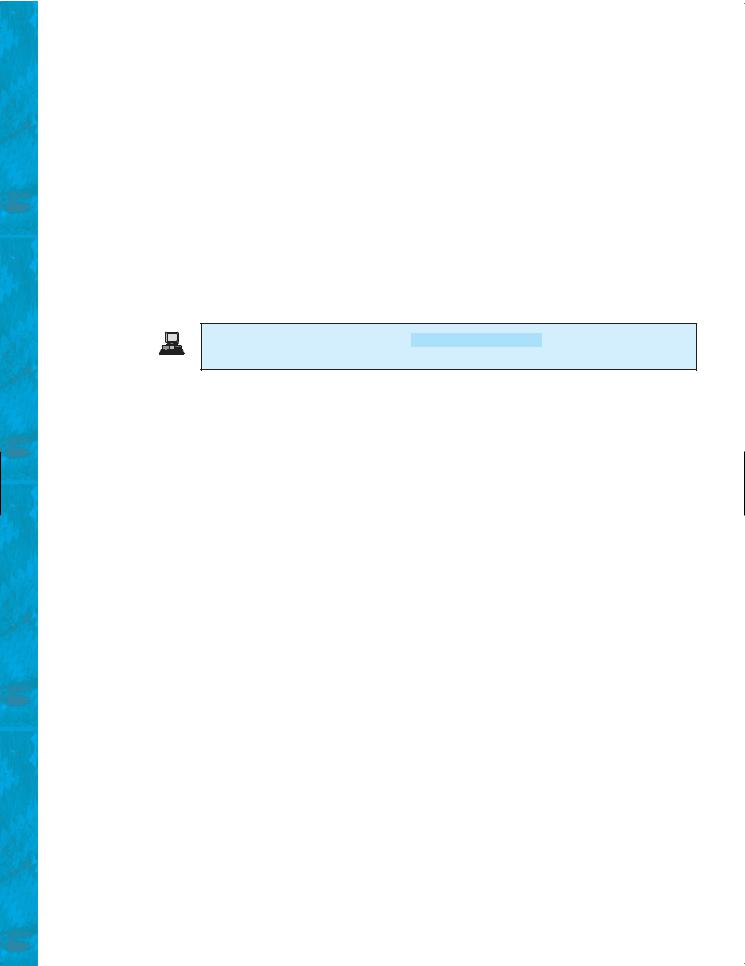
230Chapter 6 Single-Dimensional Arrays
6.14(Computing gcd) Write a method that returns the gcd of an unspecified number of integers. The method header is specified as follows:
public static int gcd(int... numbers)
Write a test program that prompts the user to enter five numbers, invokes the method to find the gcd of these numbers, and displays the gcd.
Sections 6.9–6.10
6.15(Eliminating duplicates) Write a method to eliminate the duplicate values in the array using following method header:
public static int[] eliminateDuplicates(int[] numbers)
Write a test program that reads in ten integers, invokes the method, and displays the result. Here is the sample run of the program:
Enter ten numbers: 1 2 3 2 1 6 3 4 5 2 
The distinct numbers are: 1 2 3 6 4 5
6.16(Execution time) Write a program that randomly generates an array of 100000 integers and a key. Estimate the execution time of invoking the linearSearch method in Listing 6.6. Sort the array and estimate the execution time of invoking the binarySearch method in Listing 6.7. You can use the following code template to obtain the execution time:
long startTime = System.currentTimeMillis(); perform the task;
long endTime = System.currentTimeMillis(); long executionTime = endTime - startTime;
6.17* (Revising selection sort) In §6.10.1, you used selection sort to sort an array. The selection-sort method repeatedly finds the smallest number in the current array and swaps it with the first number in the array. Rewrite this program by finding the largest number and swapping it with the last number in the array. Write a test program that reads in ten double numbers, invokes the method, and displays the sorted numbers.
6.18** (Bubble sort) Write a sort method that uses the bubble-sort algorithm. The bub- ble-sort algorithm makes several passes through the array. On each pass, successive neighboring pairs are compared. If a pair is in decreasing order, its values are swapped; otherwise, the values remain unchanged. The technique is called a bubble sort or sinking sort because the smaller values gradually “bubble” their way to the top and the larger values “sink” to the bottom. Use 56.0, 4.4, 1.9, 2.9, 3.4, 2.9, 3.56 to test the method. Write a test program that reads in ten double numbers, invokes the method, and displays the sorted numbers.
6.19** (Sorting students) Write a program that prompts the user to enter the number of students, the students’ names, and their scores, and prints student names in decreasing order of their scores.
6.20*** (Game: Eight Queens) The classic Eight Queens puzzle is to place eight queens on a chessboard such that no two queens can attack each other (i.e., no two queens are on the same row, same column, or same diagonal). There are many possible solutions. Write a program that displays one such solution. A sample
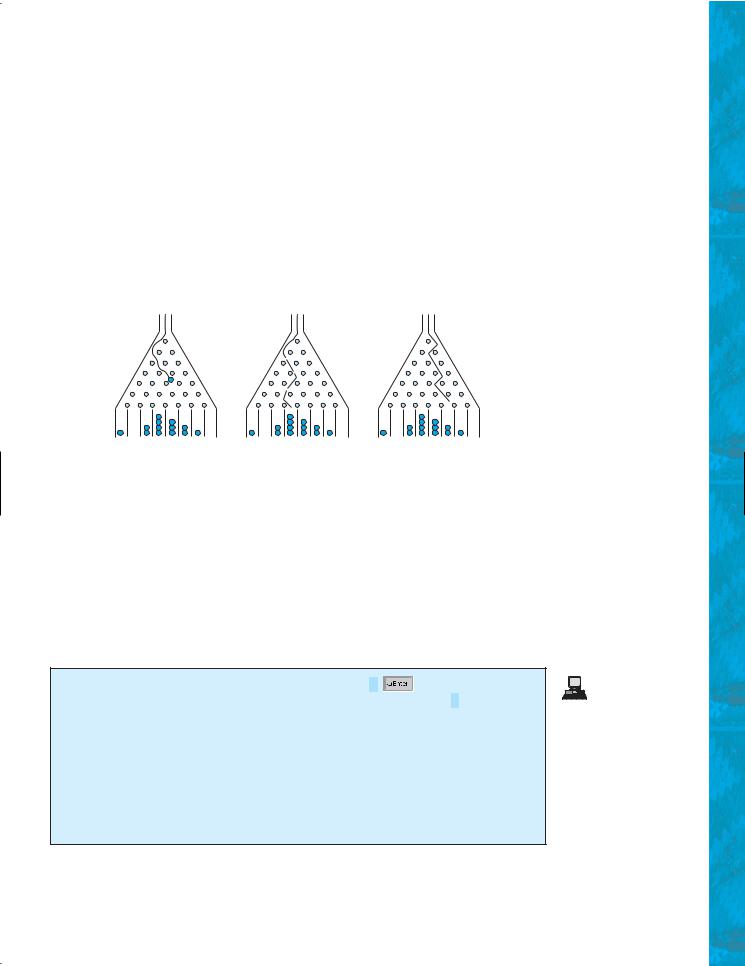
Programming Exercises 231
output is shown below:
|Q| | | | | | | |
| | | | |Q| | | |
| | | | | | | |Q|
| | | | | |Q| | |
| | |Q| | | | | |
| | | | | | |Q| | | |Q| | | | | | |
| | | |Q| | | | |
6.21*** (Game: bean machine) The bean machine, also known as a quincunx or the Galton box, is a device for statistic experiments named after English scientist Sir Francis Galton. It consists of an upright board with evenly spaced nails (or pegs) in a triangular form, as shown in Figure 6.14.
(a) |
(b) |
(c) |
FIGURE 6.14 Each ball takes a random path and falls into a slot.
Balls are dropped from the opening of the board. Every time a ball hits a nail, it has a 50% chance of falling to the left or to the right. The piles of balls are accumulated in the slots at the bottom of the board.
Write a program that simulates the bean machine. Your program should prompt the user to enter the number of the balls and the number of the slots in the machine. Simulate the falling of each ball by printing its path. For example, the path for the ball in Figure 6.14(b) is LLRRLLR and the path for the ball in Figure 6.14(c) is RLRRLRR. Display the final buildup of the balls in the slots in a histogram. Here is a sample run of the program:
Enter the number of balls to drop: 5
Enter the number of slots in the bean machine: 7 
LRLRLRR
RRLLLRR
LLRLLRR
RRLLLLL
LRLRRLR
O
O
OOO
(Hint: Create an array named slots. Each element in slots stores the number of balls in a slot. Each ball falls into a slot via a path. The number of R’s in a path is the position of the slot where the ball falls. For example, for the path
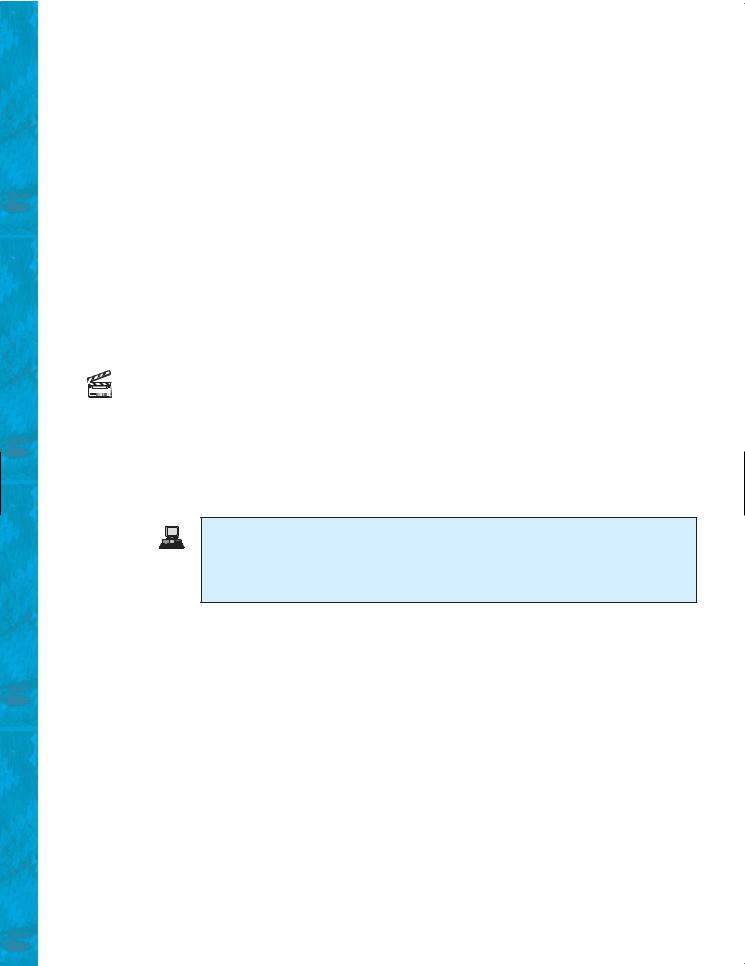
232 Chapter 6 Single-Dimensional Arrays
Video Note
Coupon collector’s problem
LRLRLRR, the ball falls into slots[4], and for the path is RRLLLLL, the ball falls into slots[2].)
6.22*** (Game: multiple Eight Queens solutions) Exercise 6.20 finds one solution for the Eight Queens problem. Write a program to count all possible solutions for the eight queens problem and display all solutions.
6.23** (Game: locker puzzle) A school has 100 lockers and 100 students. All lockers are closed on the first day of school. As the students enter, the first student, denoted S1, opens every locker. Then the second student, S2, begins with the second locker, denoted L2, and closes every other locker. Student S3 begins with the third locker and changes every third locker (closes it if it was open, and opens it if it was closed). Student S4 begins with locker L4 and changes every fourth locker. Student S5 starts with L5 and changes every fifth locker, and so on, until student S100 changes L100.
After all the students have passed through the building and changed the lockers, which lockers are open? Write a program to find your answer.
(Hint: Use an array of 100 boolean elements, each of which indicates whether a locker is open (true) or closed (false). Initially, all lockers are closed.)
6.24** (Simulation: coupon collector’s problem) Coupon collector is a classic statistic problem with many practical applications. The problem is to pick objects from a set of objects repeatedly and find out how many picks are needed for all the objects to be picked at least once. A variation of the problem is to pick cards from a shuffled deck of 52 cards repeatedly and find out how many picks are needed before you see one of each suit. Assume a picked card is placed back in the deck before picking another. Write a program to simulate the number of picks needed to get four cards from each suit and display the four cards picked (it is possible a card may be picked twice). Here is a sample run of the program:
Queen of Spades 5 of Clubs Queen of Hearts 4 of Diamonds
Number of picks: 12
6.25(Algebra: solving quadratic equations) Write a method for solving a quadratic equation using the following header:
public static int solveQuadratic(double[] eqn, double[] roots)
The coefficients of a quadratic equation ax2 + bx + c = 0 are passed to the array eqn and the noncomplex roots are stored in roots. The method returns the number of roots. See Programming Exercise 3.1 on how to solve a quadratic equation.
Write a program that prompts the user to enter values for a, b, and c and displays the number of roots and all noncomplex roots.
6.26(Strictly identical arrays) Two arrays list1 and list2 are strictly identical if they have the same length and list1[i] is equal to list2[i] for each i. Write a method that returns true if list1 and list2 are strictly identical, using the following header:
public static boolean equal(int[] list1, int[] list2)
Write a test program that prompts the user to enter two lists of integers and displays whether the two are strictly identical. Here are the sample runs. Note that the first number in the input indicates the number of the elements in the list.
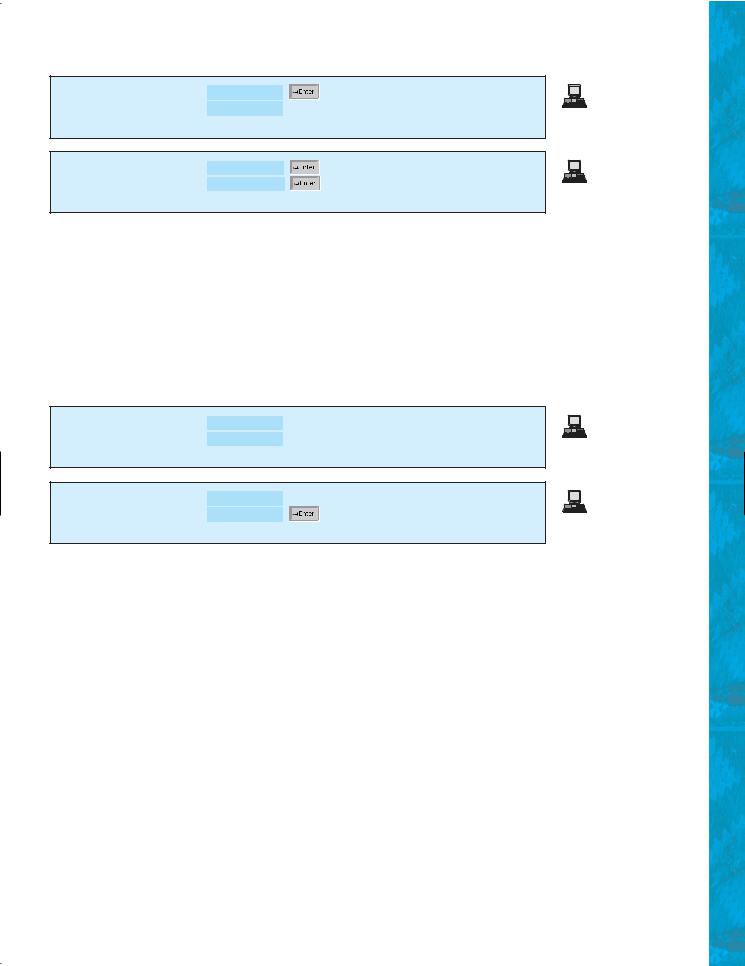
Programming Exercises 233
Enter list1: 5 2 5 6 1 6
Enter list2: 5 2 5 6 1 6 
Two lists are strictly identical
Enter list1: 5 2 5 6 6 1
Enter list2: 5 2 5 6 1 6
Two lists are not strictly identical
6.27(Identical arrays) Two arrays list1 and list2 are identical if they have the same contents. Write a method that returns true if list1 and list2 are identical, using the following header:
public static boolean equal(int[] list1, int[] list2)
Write a test program that prompts the user to enter two lists of integers and displays whether the two are identical. Here are the sample runs. Note that the first number in the input indicates the number of the elements in the list.
Enter list1: 5 2 5 6 6 1 
Enter list2: 5 5 2 6 1 6 
Two lists are identical
Enter list1: 5 5 5 6 6 1 
Enter list2: 5 2 5 6 1 6
Two lists are not identical
6.28(Math: combinations) Write a program that prompts the user to enter 10 integers and displays all combinations of picking two numbers from the 10.
6.29(Game: picking four cards) Write a program that picks four cards from a deck of 52 cards and computes their sum. An Ace, King, Queen, and Jack represent 1, 13, 12, and 11, respectively. Your program should display the number of picks that yields the sum of 24.
6.30(Pattern recognition: consecutive four equal numbers) Write the following method that tests whether the array has four consecutive numbers with the same value.
public static boolean isConsecutiveFour(int[] values)
Write a test program that prompts the user to enter a series of integers and displays true if the series contains four consecutive numbers with the same value. Otherwise, display false. Your program should first prompt the user to enter the input size—i.e., the number of values in the series.
This page intentionally left blank

CHAPTER 7
MULTIDIMENSIONAL ARRAYS
Objectives
■To give examples of representing data using two-dimensional arrays (§7.1).
■To declare variables for two-dimensional arrays, create arrays, and access array elements in a two-dimensional array using row and column indexes (§7.2).
■To program common operations for two-dimensional arrays (displaying arrays, summing all elements, finding min and max elements, and random shuffling) (§7.3).
■To pass two-dimensional arrays to methods (§7.4).
■To write a program for grading multiple-choice questions using two-dimensional arrays (§7.5).
■To solve the closest-pair problem using two-dimensional arrays (§7.6).
■To check a Sudoku solution using two-dimensional arrays (§7.7).
■To use multidimensional arrays (§7.8).
